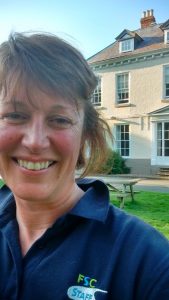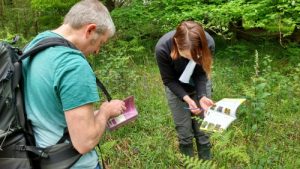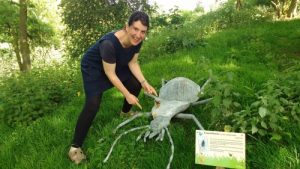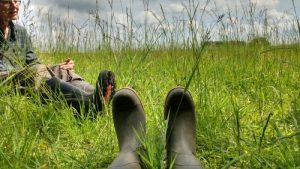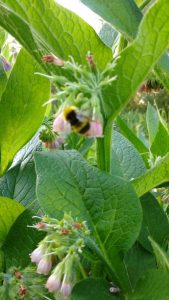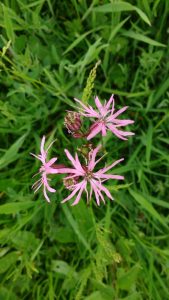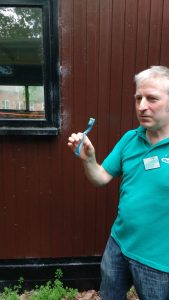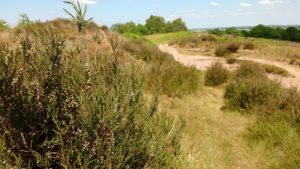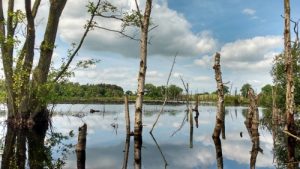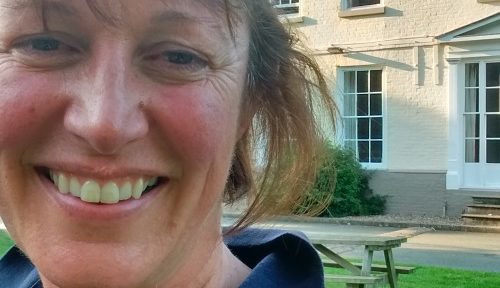
It’s only a couple of weeks since my first blog…but just like when going invertebrate hunting, my perception of time goes awry! The sun just keeps on shining in Shropshire and the rains seems to come mainly whenever I’m camping! The 5am dawn chorus has been my alarm call, and the days are full of wild life from dawn til dusk.
Rich, Charlie and I spent a blissful day on Haughmond Hill, carrying out a National Plant Monitoring Scheme (NPMS) survey. This scheme allocates volunteers a specific patch, within which 5 representative square or linear plots are chosen and surveyed a few times each year. The surveys can be carried out on one of three levels (depending on the experience of the surveyor) and a species list is supplied dependent on the habitat description. After recording all plant species within the plot, the percentage cover for each species is estimated and recorded, as is the overall percentage coverage in ranges of height. Surveys should be carried out several times of the year by the same person….for as long as they can sustain breath! It’s a real commitment, but an excellent way of providing continuity and valuable records of changing habitat and species diversity over time.
My eyes were opened to the amazing world of springtails, when TomBio (FSC Tomorrow’s Biodiversity Project) set up the lab in Preston Montford as an open day for local enthusiasts. This is a regular occurance and provides a relaxed but well-informed setting in which to learn more/ compare notes/ practice keying out/ develop skills and learn from each other. I am very touched by the genuinely warm welcome that everyone extends in the world of entomology. Don’t be put off by thinking that you don’t know anything…just come along to these events, and people will happily give you great encouragement. As I have spent more time with local entomologists, I have realised just how under-represented invertebrate recording has been. It has been largely due to the successful running of projects from the Biodiversity office in FSC, that local enthusiasts have become experts and county recorders, which is a wonderful testament to the foresight and support provided through these projects.
Oooh…more good news! I was accepted into the Chartered Institute of Ecology and Environmental Management last week, so am proud to be a “Grad CIEEM”. It will be a great way of ensuring I keep my skills up to date through CPD, and involvement in local groups. If that wasn’t exciting enough, I also passed the assessments to drive the head office car and the Preston Montford people carrier. Watch out world!!
I returned to Conwy for a wonderful day with the local recording group COFNOD, where we surveyed Cymryd, a beautiful area near the river Conwy which included salt marsh, open meadow, broad leaved woodland and hedge banks. Richard Gallon led us and shared much arachnid id knowledge, and I had the opportunity to spend some time with Lucia Ruffino on bryophytes and Julie Rose on vascular plants. Time flew, and before we realised it was 6pm. A particular highlight for me, was spotting a fox cub in the bluebell woodland. We had a good view in the dappled sunlight and then the cub silently slipped away.
Back at Preston Montford, I am working with Sami Key and we are developing our id skills together. Whenever possible, we set the moth trap and then get really excited when we correctly identify some of the moths. It’s a very satisfying way of improving your observational skills. The traps are also set at Head Office, and form a fascinating early morning diversion from the desk work, when lots of people come out to the courtyard to look and wonder at what we will find. We had a bit of drama when a nesting sparrow flew off with one of our recently released Poplar Hawk Moths (we think it was one of Dave’s relatives…follow me on Twitter for more explanation!) It wasn’t what we wanted to see…but that’s nature in the raw! Sami and I are also starting regular bee and butterfly transects around Preston Montford grounds, and our preliminary afternoon certainly made us realise which questions we need to ask in order to become really proficient at recording accurately.
Thanks to Sara Lanyon from Head Office in giving me an impromptu lesson in damsel and dragonfly id. (I am working diligently on my homework, and look forward to part 2 Sara!) I have been putting my new knowledge to immediate use, as the damsel and dragon season is now well under way. This was particularly useful over the last three days, when I have been with Pete Boardman and Kirsty Davies of Shropshire Wildlife Trust, surveying a pristine bog site (Clare Pool Moss), Crosemere and Colemere for invertebrates. The Shropshire entomology group attended the first two days, providing their usual high level of knowledge and great humour, and the third day was for volunteers who wished to improve their survey and id skills. A great success all round, and I certainly started to feel more familiar with some species.
Thanks to “Spider Nig”, Rich and Charlie for a great “Learn to Love Spiders” course in Preston Montford…loads of information, plus the fun of making and using our very own Spi pots. It was interesting that several participants admitted to a previous fear of spiders, but had found that learning more about these fascinating creatures had actually helped them to rationalise and overcome this fear. They left their audience begging for more…good job that there are a few more spider courses on offer!
The temp recorded 34 degrees in my car on the day I decided to visit my nearest heathland, The Cliffe! A hot dusty walk with magnificent views across the county. I did some plant recording, but was wilting fairly quickly. Probably too hot and sunny for amphibians too. I’ll certainly return on a cooler day!
I can’t believe how much I’ve packed in over the last few weeks. As always, my very grateful thanks to the wonderful Biodiversity team of Sue, Charlie and Rich and to all the fantastically enthusiastic ologists out there who are helping to make me feel so welcome!
Sue Loughran, TCV Natural Talent Trainee (Invertebrates and Lower Plants of Heaths and Mires).
With thanks to Field Sudies Council for hosting my placement and to the Esmee Fairbairn Foundation for funding my traineeship.

